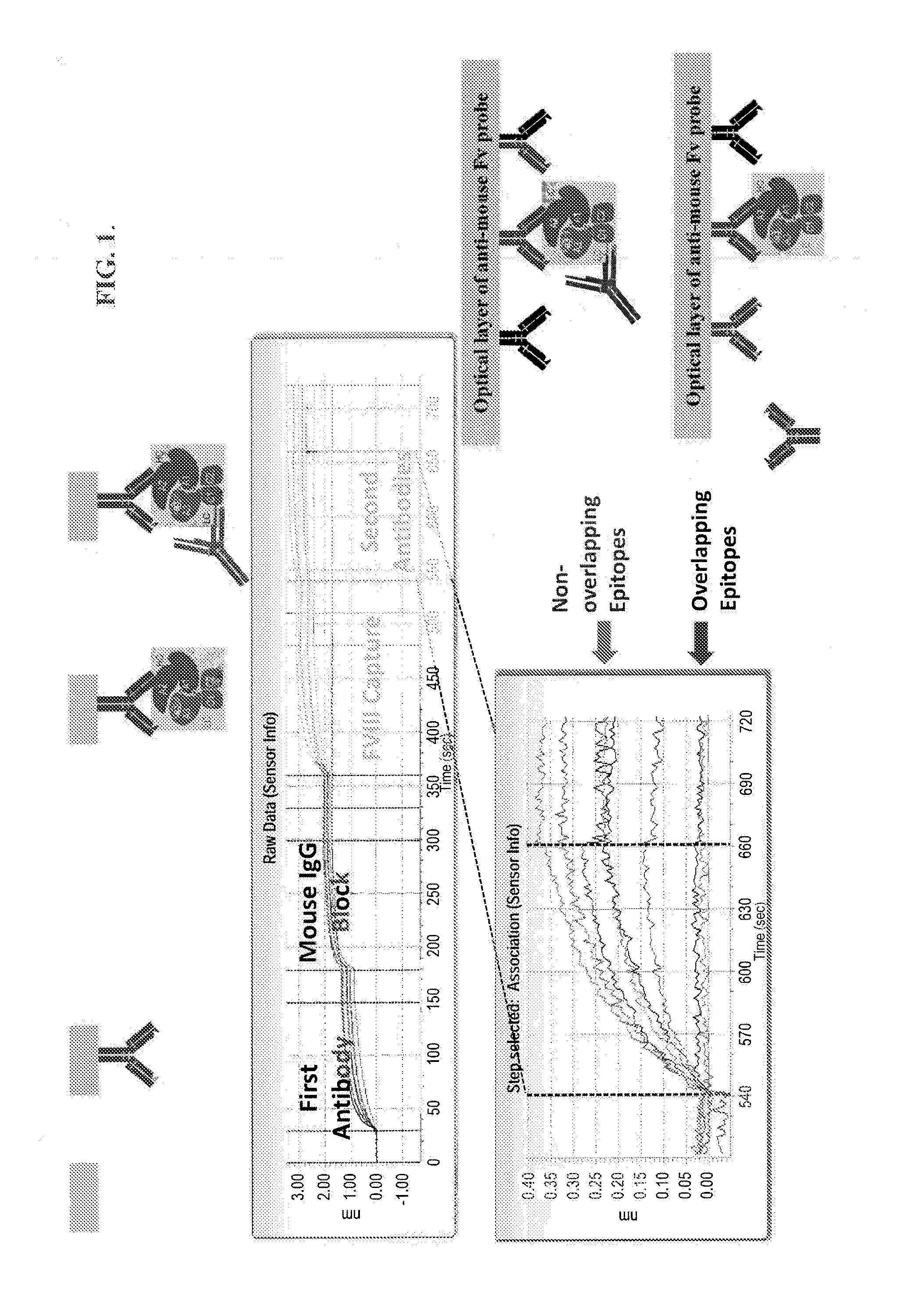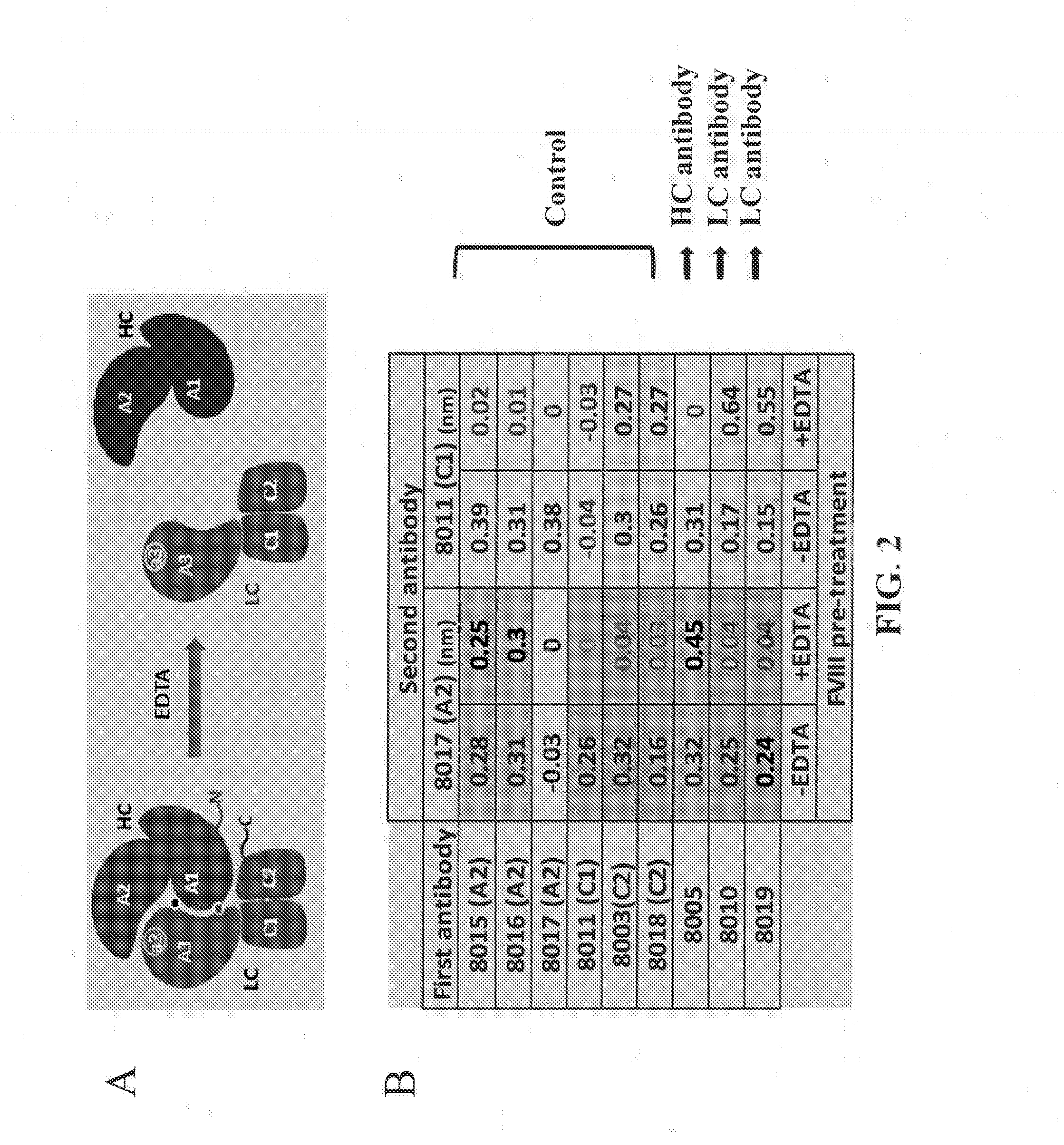Anti-factor viii antibodies or uses thereof
a technology of anti-factor viii and antibodies, which is applied in the field of anti-factor viii antibodies, can solve the problems of reducing product yield, fviii can be unstable, and can be susceptible to dissociation,
- Summary
- Abstract
- Description
- Claims
- Application Information
AI Technical Summary
Benefits of technology
Problems solved by technology
Method used
Image
Examples
example 1
Pairwise Epitope Overlap Analysis—OCTET®
[0349]ForteBio's OCTET® was used to analyze the epitope overlap among the anti-FVIII antibodies. ForteBio's OCTET® utilizes BioLayer Interferometry (BLI) technology to monitor the interaction of proteins and other biomolecules to their binders directly in real time. The binding interaction is continuously detected by measuring the change in thickness of the protein layer on the sensor tip. The detector monitors the interference pattern created by attaching a layer of molecules to the tip of an optic fiber. Any change in the number of molecules bound results in a shift in the pattern. Monitoring the interference pattern vs. time allows sensitive detection on molecular binding.
[0350]Over thirty anti-FVIII mouse monoclonal antibodies, e.g., GMA8002, GMA8005, GMA8004, GMA012, GMA8009, GMA8015, GMA8016, GMA8017, MBS11, MBS32, MBS22, GMA8001, GMA8010, GMA8019, GMA8011, GMA8020, MBS14, ESH4, ESH8, GMA8003, GMA8006, GMA8008, GMA8013, GMA8014, GMA8018,...
example 2
Immunoaffinity Purification
[0356]In order to test its application for immunoaffinity purification, a test antibody was bound to an anti-mouse Fv biosensor probe. The probe was then exposed to an elution buffer for preconditioning. FVIII was captured by the antibody bound to the probe and then tested the release by the elution buffer (50 mM Histidine, 0.9 M Arginine HCl, 50 mM CaCl2, 45% propylene glycol, 0.05% Tween20, pH 7.2). As shown in FIGS. 4A and 4B, upon exposure of the probe to an elution buffer, complete elution (left) shows a decrease in the spectral interference signal back to the level before FVIII binding while no elution (right) shows a lack of change in the signal.
example 3
Affinity Measurement
[0357]A total of 25 mouse monoclonal antibodies, representing specificities for all five structural domains of FVIII, were evaluated. FIG. 6A is representative triplicate experiments of the affinities of the GMA8014, GMA8020, GMA8011, and MBS22 antibodies for BDD rFVIII and rFVIIIFc on ProteOn. MBS22 showed very slow dissociation rate from rFVIIIFc or BDD rFVIII. To confirm the results of MBS22, as shown in FIG. 6B, the affinity was evaluated on Biacore by direct immobilization to the chip and by using long dissociation step (35 minutes). Results from both methods indicate similar affinity of MBS22 for rFVIIIFc and BDD rFVIII.
[0358]The affinities of the anti-FVIII antibodies were plotted as shown in FIG. 7. The y-axis shows rFVIIIFc affinity, and the x-axis shows BDD rFVIII affinity. The domain specificity of each antibody in the panel and the affinity is indicated in Table 1. The affinities of the antibodies for rFVIII and rFVIIIFc, expressed in terms of KD (M),...
PUM
| Property | Measurement | Unit |
|---|---|---|
| Fraction | aaaaa | aaaaa |
| Fraction | aaaaa | aaaaa |
| Fraction | aaaaa | aaaaa |
Abstract
Description
Claims
Application Information
 Login to View More
Login to View More - R&D
- Intellectual Property
- Life Sciences
- Materials
- Tech Scout
- Unparalleled Data Quality
- Higher Quality Content
- 60% Fewer Hallucinations
Browse by: Latest US Patents, China's latest patents, Technical Efficacy Thesaurus, Application Domain, Technology Topic, Popular Technical Reports.
© 2025 PatSnap. All rights reserved.Legal|Privacy policy|Modern Slavery Act Transparency Statement|Sitemap|About US| Contact US: help@patsnap.com



